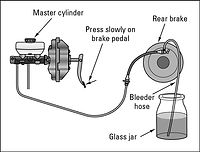
How to Do a Brake Fluid Flush (and Why It Matters)
Performing a brake fluid flush is essential car maintenance—removing old fluid and replacing it with fresh brake fluid enhances safety, prolongs brake life, and prevents corrosion. Learn step‑by‑step how to flush your brake fluid and explore its key benefits.
What Is a Brake Fluid Flush?
Signs You Need a Brake Fluid Flush
A brake fluid flush removes contaminated or moisture‑laden brake fluid from the entire braking system—master cylinder, lines, calipers—and replaces it with fresh fluid. Its goal? Restore optimal hydraulic pressure and braking performance.
Watch for these warning signals:
-
Spongy or soft brake pedal (due to moisture/air in lines)
-
ABS warning light triggered by low fluid or sensor issues
-
Inconsistent braking performance, longer stopping distances
-
Dark or burnt‑smelling fluid, strange sounds during braking
Benefits of Brake Fluid Flush
-
Improved brake performance & safety – Fresh fluid helps prevent brake fade and vapor lock by maintaining a higher boiling point
-
Corrosion prevention – Removes moisture that causes rust inside calipers, lines, and master cylinders
-
Extends brake system lifespan – Protects expensive components and prevents sludge buildup
How Often to Flush Brake Fluid
Recommended interval:
-
Every 2 years or 30,000–50,000 miles (or sooner in humid regions)
Step‑by‑Step DIY Flush
Step 1: Prep the Vehicle
Park level, chock wheels, remove wheels starting from the farthest from master cylinder
Step 2: Drain Master Reservoir
Use a syringe or vacuum pump to extract old fluid — keep topped up to avoid air ingress
Step 3: Attach Bleeder Tube & Start Flush
Connect clear tubing to bleeder nipple, open ~1/4 turn
Step 4: Bleed the Brakes
Two-person method: Have one press, hold brake pedal; the other opens valve to let old fluid flow until you see clean fluid
Step 5: Repeat Sequence
Work from furthest wheel to closest; continuously top up reservoir
Step 6: Final Level Check & Road Test
Ensure reservoir capped at “Full”, no leaks, solid pedal feel after a test drive

FAQs
-
Can I top off old fluid?
No—this only dilutes contaminants without removing them -
How much does it cost?
Typically $70–$150 at a shop; kit costs vary for DIY. -
Can I mix DOT fluid types?
Avoid mixing — match the spec (DOT 3, 4, 5.1) to prevent chemical incompatibility
Alternatives to DIY
-
Pressure‑bleeder or vacuum‑bleeder kits offer single‑person convenience
-
Professional mechanic services— deeper cleaning, ABS circuit included, takes ~30–60 minutes

